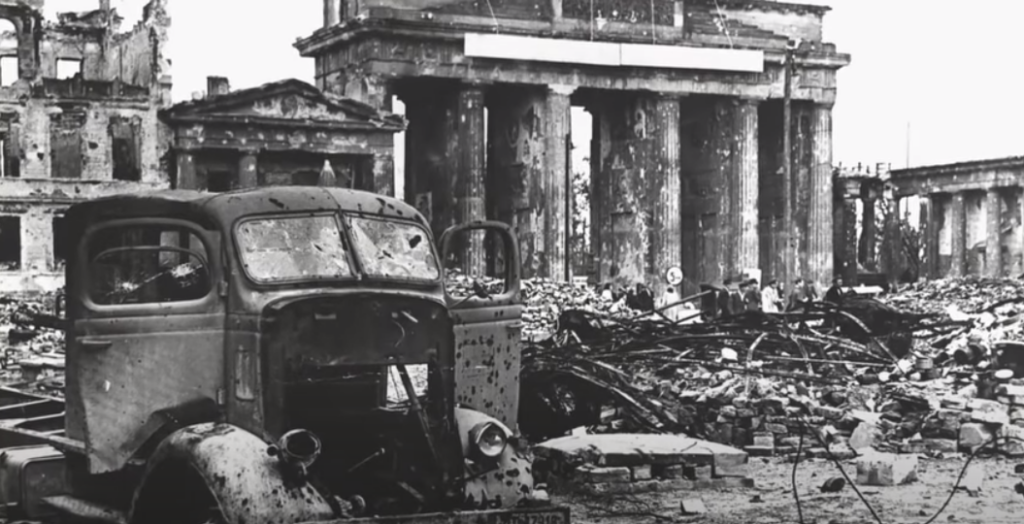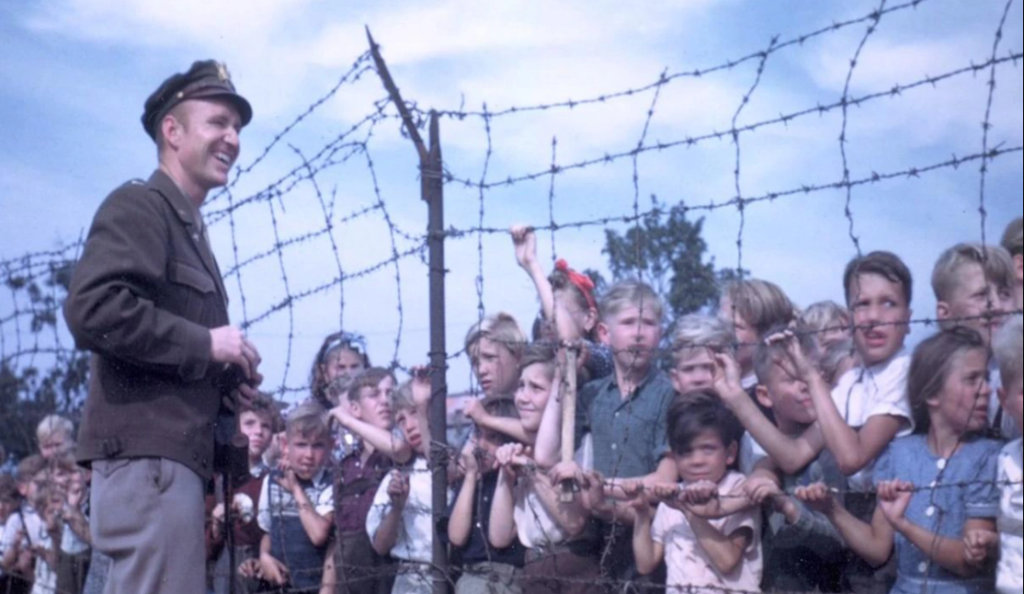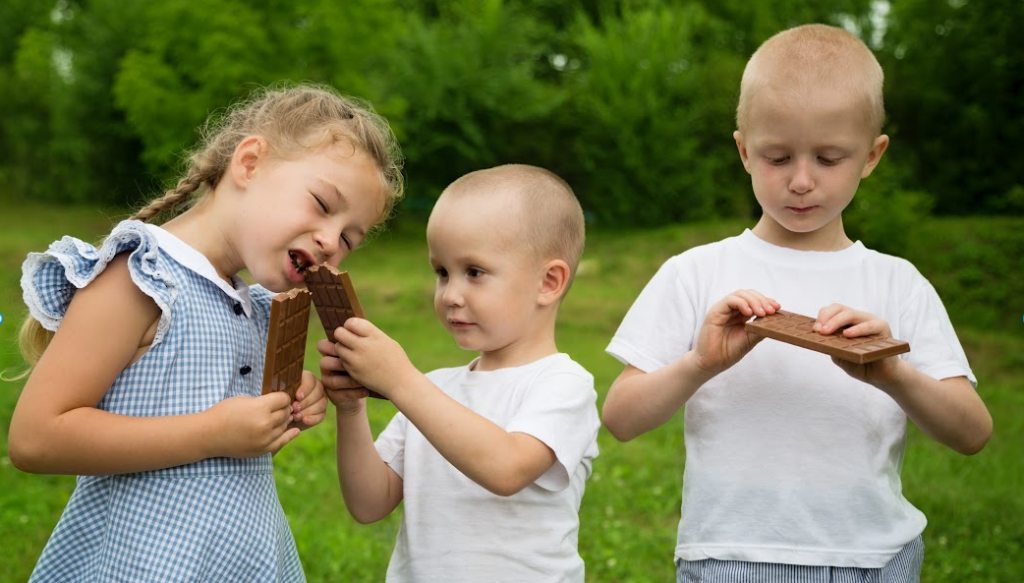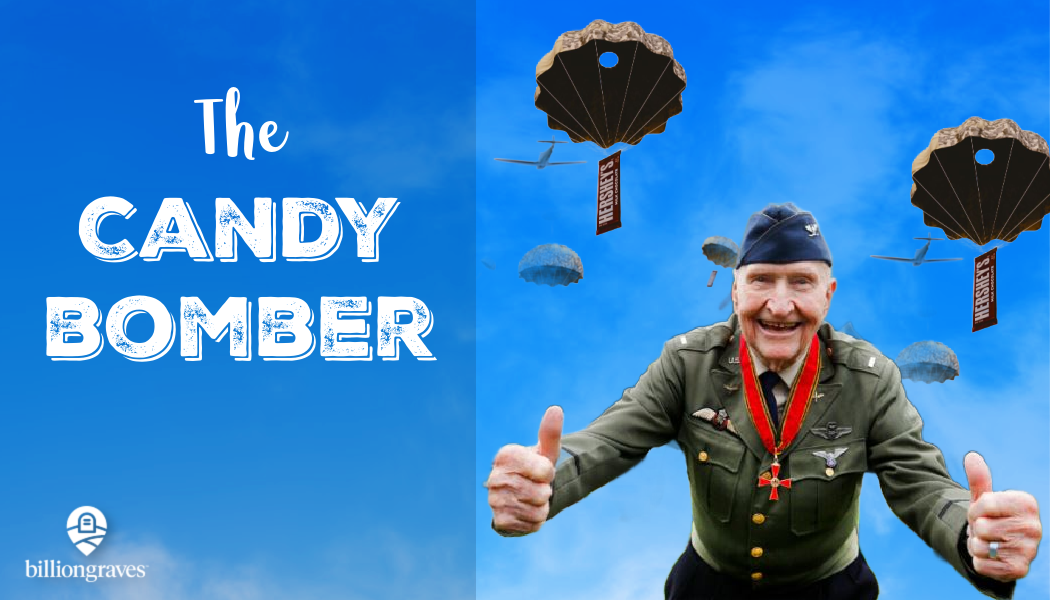The Candy Bomber was a nickname given to World War II pilot, Colonel Gail S. Halvorsen (1920 – 2021). He became well-known for dropping candy tied to miniature parachutes from his plane to German children in Berlin from 1948 to 1949.

Halvorsen was also known as “Uncle Wiggly Wings” since he wiggled the wings of his plane to let children know that chocolate was incoming. German children called him “Der Schokoladen Flieger” or “The Chocolate Flyer”.

In February of 2022, Halvorsen passed away and was laid to rest in the Provo City Cemetery in Provo, Utah alongside his wife, Alta.
BillionGraves’ gravestone photos help to preserve the history of amazing lives – like that of The Candy Bomber.
The Candy Bomber, Gail Seymour Halvorsen
During his lifetime, Halvorsen spoke of his early years, saying, “I began my life on small farms in Idaho and Utah. Things were peaceful.

“I received a flight scholarship for a private pilot license. I flew Civil Air Patrol missions. Then came Pearl Harbor and everything changed. I trained as a fighter pilot with the Royal Air Force then served as a transport pilot in the South Atlantic Theater of Operations.”
After the war, Halvorsen was called to participate in the Berlin Airlift, a joint effort by America and the United Kingdom to deliver food and aid to the people of Berlin.

He was 27 at the time and did not relish the idea of returning to Germany just as his life as a civilian was beginning to return to normal. He was reconnecting with his family. He had just purchased a red Chevy – the first new car of his life. He wanted to find a wife and settle down to start a family.
But his character was to always put “service before self” so he said good-bye to his family, pocketed the key to his new car, and boarded a plane back to Germany.

Halvorsen wrote, “When World War II ended, the last thing I ever thought might happen was that in 1948 I would be in Europe, flying day and night to Berlin. Flights would be in thunderstorms, fog, ice, and snow to feed the former enemy.
“On my first trip to Berlin, the flattened ruins of the once proud and sophisticated capital looked like a moonscape as the wreckage passed beneath the wings of my flour-laden C-54 Skymaster.”

He continued, “Below my wings were splintered buildings, gaping to the sky with open roofs. Their once stately walls were broken into individual bricks and scattered in the streets and across lots now vacant; lots that once held architecturally classic buildings.”

“One of my fellow airlift pilots had bombed Berlin during the war. I asked him how he felt about flying day and night on behalf of the enemy, the very ones who did their best to kill him as he flew over Berlin in 1944. He hesitated a moment, shuffling his feet, and then said, “It feels a lot better to feed them than it does to kill ’em.”
Operation Vittles
Dropping candy was a happy sideline to the bigger mission of delivering food to the German people.

When Germany surrendered in 1945, the victorious Allies divided the country into four occupation zones. The Soviet Union occupied the eastern part of Germany and East Berlin, while Britain, France, and the United States took control of the western zones of Germany and West Berlin.
The United States and the United Kingdom hoped that Germany would return to self-government following the war but the Soviets wanted to maintain control over Germany.
So the Soviet Union set up a blockade to prevent food and other supplies from being shipped into the areas of West Berlin that had become the jurisdictions of the Western Allied powers (the United States, the United Kingdom, and France). The objective was to cause the Allies nations to abandon their posts and German civilians to become submissive by starving them out.

In West Berlin, about 2.5 million people were cut off from the rest of Germany, preventing them from getting food and supplies, as their freedoms were taken away.
Halvorsen said, “A victim of the blockade once told me. ‘Without hope the soul dies.’”

The Allies set up the Berlin Airlift – AKA Operation Vittles – to meet the needs of the people of western Berlin.
The Berlin Airlift could not fly in fresh food, only dehydrated food such as dried eggs, dried potatoes, dried meat, dried vegetables, and dried milk. Coal was also flown in so families could heat their homes.
For 14 months, the German children lived on just 750 calories a day, and the adults on 1,250 calories a day.

But Operation Vittles gave them hope. Hope that someone cared. Hope for freedom.
The goal of Operation Vittles was for allied cargo planes to deliver 4,500 tons of food, fuel, and other supplies per day to the people who lived in West Berlin.
Operation Vittles not only succeeded, it exceeded expectations. On April 16, 1949, the U.S. and British cargo planes delivered a record 12,941 tons of coal and food to West Berlin in just one day.

Eventually, Operation Vittles became the largest humanitarian airlift operation in history. It ran non-stop 24 hours a day with more than 1,000 flights arriving daily.
The planes landed about every 60 seconds around the clock. Pilots did not even shut down their engines. They were served refreshments as their cargo was rapidly unloaded and then quickly took to the skies again.
The Candy Bomber
There was a barbed wire fence around the air base at Tempelhof in Berlin. Halvorsen said, “One day in July 1948 I met about 30 kids at the barbed wire fence. They were so excited.”
Halvorsen talked to a few of them that spoke English and then turned to leave. He got about one step away when a message came to his mind, so clear that it seemed like a command: “Go back. Go back to the fence.”
He quickly searched his pockets for something to give them. He said, “All I had was two sticks of gum. I worried that if I gave them to that many children fights would break out. But I broke them in two and passed them through the barbed wire.”

He continued, “The result was unbelievable. Those with the gum tore off strips of the wrapper and gave them to the others. Those with the strips put them to their noses and smelled the tiny fragrance. The expression of pleasure was unmeasurable.”
He said, “I was so moved by what I saw and their incredible restraint that I promised them I would drop enough gum for each of them the next day as I came over their heads to land. They would know my plane because I would wiggle the wings as I came over the airport.”

When Halvorsen got back to base he attached gum and chocolate bars to three handkerchief parachutes. The next day, he wiggled the wings of his plane and delivered the goods.
Operation Little Vittles
That was only the beginning.
Halvorsen continued to go the extra mile by dropping candy attached to handkerchief parachutes to the children of Berlin.

A news reporter got word that large groups of German children were waiting each day for Onkel Wackel Flügel (Uncle Wiggley Wings) to drop chocolates from the sky. He wrote an article that was published throughout Europe.
When Halvorsen’s superior officer heard of it, he summoned Halvorsen to his office. Fearing he was going to be court-martialed, Halvorsen entered with dread. But to his surprise, he was commended and told that his efforts were going to be expanded into an official military operation. It was dubbed “Operation Little Vittles.”
Halvorsen wrote in retrospect, “. . . there is one human characteristic above all others that gave it birth … the silent gratitude of the children at a barbed wire fence in Berlin, July 1948.

“They did not beg for chocolate. Because not one child begged, thousands received over 21 tons of candy from the sky, or delivered on the ground, over the next 14 months (from 20,000 parachutes!)”
Halvorsen said, “Freedom was more important than a full stomach or a rare treat. It was hope, not the flour, that gave the West Berliners the strength to carry on.”
Children Loved The Candy Bomber
Halvorsen wasn’t alone in his desire to bless the children of Germany – those innocent little ones who were experiencing the consequences of war. Each night he found that his bed was covered in candy and gum that had been dropped off by other airmen who heard about what he was doing.
Schoolchildren from around the world, as well as their families and others, donated candy to the cause. A committee was set up in Massachusetts in the United States to coordinate shipping and to make the tiny parachutes.

Halvorsen started to receive thank you notes from the grateful German children. At first, the envelopes trickled in. Later, they were delivered by the boxful.
Extra secretarial staff was hired on the military base to handle all of the mail.
Children sent pencil drawings.
They sent little watercolor paintings.
Others sent photographs of themselves and notes in their best handwriting.
Children who heard about The Candy Bomber, but who had not received any candy yet themselves, wrote letters of request.

Halvorsen remembered one in particular:
“A little girl, Mercedes, wrote that I scared her chickens as I flew in to land but it was OK if I dropped the goodies where the white chickens were. ‘When you see the white chickens, drop it there. I don’t care if it scares them.’ I couldn’t find her chickens so I mailed her chocolate and gum through the Berlin mail.”
“Twenty-two years later in 1970,” he continued, “I was assigned as the commander of Tempelhof. One letter writer kept asking us to come to dinner. In 1972, we accepted.
“The lady of the house handed me a letter dated November 1948. It said, ‘Dear Mercedes, I can’t find your chickens. I hope this is OK. Your Chocolate Uncle.’ I had attached a box of candy and gum. The lady said, ‘I am Mercedes. Step over here and I will show you where the chickens were.’”

Between September 1948, and May 1949, the operation started by The Candy Bomber dropped over 23 tons of candy to the children of Berlin.
By May 13, 1949, the Soviets realized that the blockade was ineffective so they reopened land routes between West Berlin and the rest of Germany.
Remembering the Sacrifice
The German children remembered those candy parachute gifts from the sky for the rest of their lives.

In 2016, retired U.S. Air Force Col. Gail Halvorsen was invited to speak at the reopening ceremony of the Berlin Airlift Memorial outside Frankfurt International Airport, Germany.

At the age of 96, The Candy Bomber was honored as children sang songs and his good deeds were retold. And as in 1948, Halvorsen shared sweets with the children.
On the occasion, Halvorsen said, “These children had nothing, nothing at all. I am grateful that I can be here today and wish that future generations will also visit this place as a symbol of the friendship between Germany and America.”
The Candy Bomber Delivered More than Candy
But there was always more to it than just the candy. Halvorsen’s main goal was to raise the morale of the children during a time of uncertainty.

Halvorsen remembered one instance when a man told him, “I’m 60 years old, and 50 years ago, I was going to school in Berlin. It was raining. Suddenly out of the cloud and rain came a parachute. A fresh Hershey candy bar landed right at my feet.”
He continued, “It took me a week to eat that candy bar. I had it day and night. But the chocolate wasn’t important. The important thing was that somebody in America knew our troubles. Somebody cared. I can live on thin rations, but not without hope.” (Source)

Children who were able to meet “their” Candy Bomber in their later years were delighted.

And it brought Halvorsen joy right up to the end of his life.
The Candy Bomber’s Legacy

In all his remaining years, Halvorsen was honored with certificates, photos, handshakes, and smiles in recognition of the light he brought to others during World War II.

In 2008, Retired U.S. Air Force Lt. Col. Gail S. Halvorsen piloted the C-54 Skymaster “Spirit of Freedom” while performing a flyover during a New York Yankee spring training game.

In 2009, Halvorsen delivered the keynote address at the dedication ceremony of the Defense Humanitarian Relief Corridor in the Pentagon.

The corridor features a display of candy tied to handkerchief parachutes like those Halvorsen dropped to children during the Berlin Airlift.

In 2012, the C-17 Aircrew Training Center was dedicated in honor of retired Retired Col. Halvorsen at Joint Base Charleston, South Carolina to recognize him as one of the finest mobility legends.

Eventually, Halvorsen’s flights came to end. He passed away in February of 2022, leaving behind a legacy rivaled by few.
He is buried next to his wife in the Provo, Utah cemetery.
His Granddaughter is Walking in his Footsteps
Halvorsen’s granddaughter, Lucy Teichert, told me about how her grandfather’s example has impacted her life. She said, “I grew up listening to my grandpa talk very often about his story, and the values he held because of it.
“In particular, three of his main mantras are service before self, attitude of gratitude, and from small things come big things. I still get emotional telling about or reading his story.

“He never imagined giving kids two sticks of gum would turn into a lifelong mission of sharing his testimony and the importance of being grateful and giving.
“As the years go by, it is most inspiring for me to hear people around the world expressing how he has influenced their lives. People go to great lengths to honor him and the Candy Bombers’ legacy. It’s amazing to me to see people really come together with full hearts because of the principles of service and gratitude.

“When you’re talking to my grandpa, no matter who you are – reporter, waitress, family member, etc. – you feel like you’re the most important person in the world. He always has something positive to say, and usually calls everyone ‘sunshine’. You just . . . know you matter.
“And I know that’s what my grandpa has done all his life for everyone he meets. I feel a desire, and, in fact, an obligation to do and be better because I’m his granddaughter.”
The Candy Bomber’s Gravestone
There is so much that can be learned from a gravestone – including The Candy Bombers’ gravestone! They are one of the best resources for finding information about your ancestors to grow your family tree.

As you can see from the birth and death dates, Gail Halvorsen lived to be 101 years old!

His wife preceded him in death by more than 23 years.

But prior to her death, they had been married for nearly 50 years!

The engraving of the temple shows that the Halversens were members of The Church of Jesus Christ of Latter-day Saints.
Below the picture of the temple, there is a date of 16 Sept 1950. That marks the date that the couple was “sealed” or “married for time and all eternity” in the temple. This ceremony meant that the couple was not married “until death do you part” but rather sealed together forever and ever.

Pinecones and evergreen boughs on a gravestone are symbols of everlasting life since pine trees do not lose their leaves nor look dead during the winter.
Click HERE to learn more about gravestone symbols.

Nicknames on a gravestone can reveal the character or hobbies of our ancestors. The Halvorsen’s gravestone has nicknames written above their names. Hers says, “His Angel” and his says, “Her Candy Bomber”.
Click HERE and HERE to learn more about using gravestones to find clues about your ancestors.

For the sources of information and to learn more, click HERE for the Gail S. Halvorsen Foundation webpage.
Volunteering to Take Gravestone Photos
The BillionGraves app helps preserve history and family memories.
We need your help to take photos of gravestones! It’s easy and done completely with your smartphone! Click HERE to get started.

You are welcome to do this at your own convenience, no permission from us is needed. If you still have questions after you have clicked on the link to get started, you can email us at Volunteer@BillionGraves.com. We’ll be happy to help you!
Are you planning a group service project? Email us at Volunteer@BillionGraves.com for more resources. We will help you find a cemetery that still needs to have photos taken.
Will We See You at RootsTech?

RootsTech, the world’s largest genealogy conference, will be offered both virtually and in person at the Salt Lake Palace in Salt Lake City, Utah. If you will be there in person, stop by booth #335 to say hi to the BillionGraves team or look for us on the RootsTech virtual website. Click HERE for more information about RootsTech.
Happy Cemetery Hopping!
Cathy Wallace






